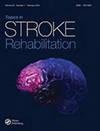对中风后上肢康复随机对照试验中评估的上肢康复结果进行系统回顾。
IF 2.5
4区 医学
Q1 REHABILITATION
引用次数: 0
摘要
背景脑卒中后康复试验结果测量的异质性表明,需要在脑卒中康复测量方面达成共识。为了实现这一目标,了解卒中康复随机对照试验(RCT)中过去和现在使用的结果测量方法非常重要。目的系统回顾卒中后超音速康复干预的 RCT,了解超音速结果测量方法在研究中的使用及其随时间的变化。符合以下条件的研究均可纳入:(1)以英语发表的 RCT 或交叉研究;(2)≥50% 的参与者受中风影响;(3)纳入年龄≥18 岁的成年人;(4)将干预偏瘫 UE 作为研究的主要目标。结果1,276 项 RCT 符合纳入标准,确定了 112 种不同的结果测量。研究结果根据国际功能、残疾和健康分类(ICF)框架进行了分类。结果测量最常评估的是身体功能和结构(1,692 例),其次是活动(1,572 例)和参与(162 例)。使用最多的结果测量方法是 Fugl-Meyer 评估(n = 619)、修改后的 Ashworth 量表(n = 255)、行动研究手臂测试(n = 211)、Wolf 运动功能测试(n = 184)以及盒块测试(n = 178)。本文章由计算机程序翻译,如有差异,请以英文原文为准。
A systematic review of upper extremity outcome measures assessed in randomized controlled trials of post stroke upper extremity rehabilitation over time.
BACKGROUND
The heterogeneity in outcome measures of post stroke rehabilitation trials suggests the need for consensus approach in stroke recovery measurement. To reach this aim, it is important to understand the past and current use of outcome measures in randomized control trials (RCTs) of stroke rehabilitation.
OBJECTIVE
To systematically review RCTs of post stroke UE rehabilitation interventions to understand the use of UE outcome measures in research and their changes over time.
METHODS
CINAHL, Embase, PubMed, Scopus and Web of Science were searched from 1960 to 1 April 2021. Studies were eligible for inclusion if they (1) were RCTs or crossovers published in English (2) ≥50% of participants were affected by stroke, 3) included adults ≥ 18 years old, and (4) applied an intervention to the hemiparetic UE as the primary objective of the study.
RESULTS
1,276 RCTs met inclusion criteria, and 112 different outcome measures were identified. Outcome measures were classified according to the International Classification of Functioning, Disability and Health (ICF) framework. Outcome measures most frequently assessed body function and structure (n = 1,692), followed by activities (n = 1,572) and participation (n = 162). The most used outcome measures were the Fugl-Meyer Assessment (n = 619), the modified Ashworth Scale (n = 255), Action Research Arm Test (n = 211), Wolf Motor Function Test (n = 184), and Box and Block Test (n = 178).
CONCLUSIONS
Understanding the breadth of outcome measures that have been used over time emphasizes the need for proposed standardization of outcome measures but also the need to adjust and expand consensus recommendations based on past and ongoing research trends.
求助全文
通过发布文献求助,成功后即可免费获取论文全文。
去求助
来源期刊

Topics in Stroke Rehabilitation
医学-康复医学
CiteScore
5.10
自引率
4.50%
发文量
57
审稿时长
6-12 weeks
期刊介绍:
Topics in Stroke Rehabilitation is the leading journal devoted to the study and dissemination of interdisciplinary, evidence-based, clinical information related to stroke rehabilitation. The journal’s scope covers physical medicine and rehabilitation, neurology, neurorehabilitation, neural engineering and therapeutics, neuropsychology and cognition, optimization of the rehabilitation system, robotics and biomechanics, pain management, nursing, physical therapy, cardiopulmonary fitness, mobility, occupational therapy, speech pathology and communication. There is a particular focus on stroke recovery, improving rehabilitation outcomes, quality of life, activities of daily living, motor control, family and care givers, and community issues.
The journal reviews and reports clinical practices, clinical trials, state-of-the-art concepts, and new developments in stroke research and patient care. Both primary research papers, reviews of existing literature, and invited editorials, are included. Sharply-focused, single-issue topics, and the latest in clinical research, provide in-depth knowledge.
 求助内容:
求助内容: 应助结果提醒方式:
应助结果提醒方式:


